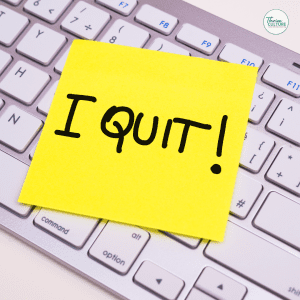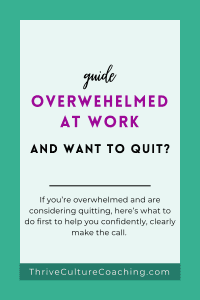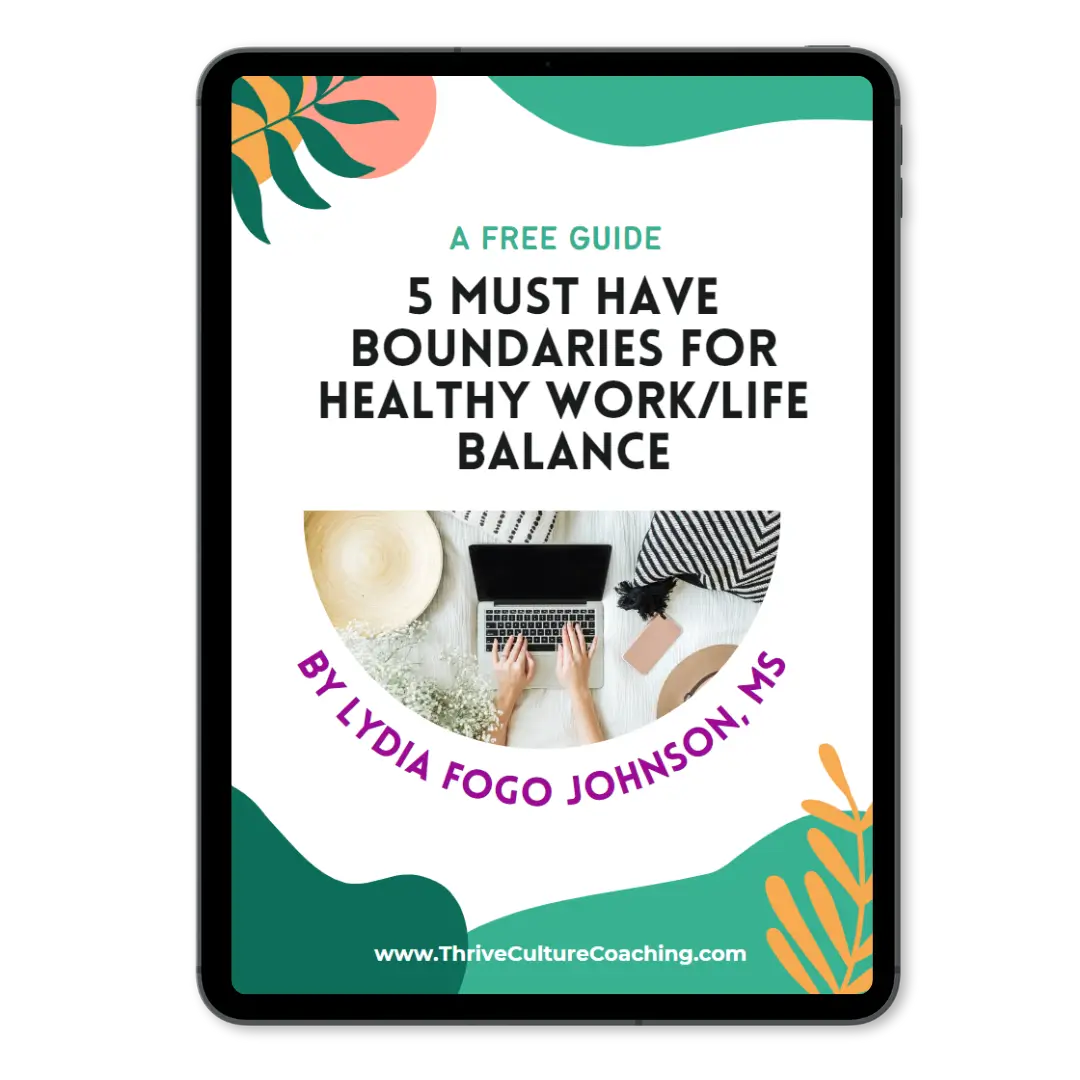Table of Contents
Overwhelmed at Work and Want to Quit? How to Decide Whether to Stay or Go
You close your laptop at 10:30 PM — again. The dishes are still in the sink. Your Slack is still pinging. And your brain? Spinning with questions like:
Is it the job? Is it me? Do I just need a break — or a whole new life?
If you’ve been refreshing job listings at midnight, crying in the car, or mentally drafting your resignation letter during your lunch break… you’re not alone.
Burnout doesn’t always announce itself with a breakdown. Sometimes, it shows up as a slow drain — the kind that leaves you second-guessing everything and wondering whether quitting is your only way out.
This guide is here to help you figure that out. Because if you’re overwhelmed at work and want to quit, you don’t need a pep talk — you need clarity.
I’m Lydia, a certified burnout and leadership coach, and I’ve helped countless high-achieving women navigate this exact moment. Women like Molly — a director at a SaaS company and mom of two — who once loved her work, but found herself constantly on edge, exhausted, and unsure if staying was even an option.
Together, we untangled her stress, rebuilt her capacity, and helped her make real, sustainable shifts — both in her role and in her life.
Let’s do the same for you.
Constantly Feeling Overwhelmed? It’s Not Just You
Feeling overwhelmed at work isn’t a sign that you’re broken — it’s a sign that something is off. And more often than not, that something is bigger than just your calendar.
In 2023, 65% of employees report experiencing burnout. But for women — especially working moms and leaders — that number is even higher. Why?
Because you’re not just juggling deadlines. You’re carrying invisible labor, navigating unspoken expectations, and compensating for systems that weren’t designed to support you.
So when burnout hits, it’s easy to turn the blame inward:
“Why can’t I handle this anymore?”
“What’s wrong with me?”
“Everyone else seems fine…”
Here’s the truth: It’s not you. It’s the system.
Burnout isn’t a personal failure. It’s a systemic issue — one that shows up in your calendar, your nervous system, and your sense of self.
Before you go any further, take a breath and remember:
You are so much more than this stressful moment.
And it is not your fault that you’re overwhelmed.
Step 0 – Before You Quit Your Job: A Reality Check
If you’re tempted to quit your job today, I get it.
But before you rage-apply to 12 new roles or fire off your resignation email, it’s worth hitting pause — not because staying is the better choice, but because quitting in burnout mode can sometimes make things harder, not easier.
Here’s what quitting actually costs:
-
You’ll need to rebuild trust and authority in a new role (typically takes 6–12 months)
-
Job searches can take 3–6 months and 5–10 hours/week
-
You may lose income, PTO accrual, healthcare, or bonuses
-
Onboarding stress is real — most people feel more stressed during their first 90 days
-
If burnout habits (like people-pleasing or poor boundaries) go unaddressed, they’ll follow you
Leaving might still be the right choice. But let’s make it a strategic decision — not an escape hatch.

Step 1 – Understand the Root of Your Overwhelm
Not all stress means it’s time to leave. Sometimes, what you’re feeling is situational — and solvable. Other times, it’s a sign you’ve outgrown the role, or that something deeper needs to shift.
Here are seven of the most common causes of overwhelm I see in my coaching practice — and how to think about each one:
🌀 Acute Stress
Example: It’s audit season or you’re in the middle of a product launch.
Quit or Stay? Stay. If there’s a clear end in sight, it’s wiser to get through it and recover than add a job search to your plate.
🧠 Personal Life Spillover
Example: Childcare chaos, caregiving, health issues.
Quit or Stay? Only if your job truly can’t accommodate your life circumstances. Otherwise, seek support and flexibility first.
🧩 New Job Overload
Example: You just started a new role and feel lost.
Quit or Stay? Stay — unless it’s toxic. Most adjustment periods are stressful. Ask for help, name what you need, and give it time.
☢️ Toxic Environment
Example: Gaslighting, harassment, discrimination.
Quit or Stay? Go. Immediately. No job is worth your mental health or safety.
🧍 Work Relationship Conflict
Example: A micromanaging boss or difficult colleague.
Quit or Stay? Depends. Some dynamics can be improved with coaching or boundaries — others are dealbreakers.
🎭 Imposter Syndrome
Example: You’re competent but feel like a fraud.
Quit or Stay? Stay. This is a mindset issue, not a job problem. Confidence coaching and inner work can make a big difference.
🔥 Burnout
Example: Chronic stress, emotional exhaustion, constant dread.
Quit or Stay? It depends. With the right tools, it’s often possible to recover without quitting — but only if the environment can support your healing.
Take a moment. Which of these feels most like what you’re living?
The 4 Types of Burnout (And Why It Matters)
Let’s get one thing clear: burnout isn’t one-size-fits-all.
Most people think of burnout as sheer exhaustion — but in reality, it can look like boredom, disconnection, resentment, or just… flatness.
If you’ve been trying the usual “fixes” (like self-care or better time blocking) and still feel stuck, it’s probably because you’re dealing with the wrong kind of burnout strategy for the kind you actually have.
Here are the four most common types I see with my clients — which one sounds most like you?
1️⃣ Overload Burnout: You’re Always “On” — and Always Behind
What it looks like:
You’re sprinting through your days, skipping breaks, working late, and still feel like you’re dropping balls. There’s never enough time, and your body is paying the price.
Red flags:
-
Long hours, skipped PTO, no downtime
-
“I just need to get through this week” (every week)
-
Physical symptoms: headaches, insomnia, gut issues
-
Irritability or snapping at people you care about
What helps:
You need more than time management. You need to stop living in crisis mode. That means:
-
Redesigning your workload
-
Setting enforceable boundaries
-
Giving yourself permission to slow down before your body makes you
2️⃣ Under-Challenge Burnout: You’re Coasting — and It’s Crushing You
What it looks like:
You’re not overwhelmed… but you’re underwhelmed. Your work feels repetitive, and you’re slowly detaching from it.
Red flags:
-
Dreading work that’s technically “easy”
-
Little feedback, recognition, or growth
-
Feeling like your potential is being wasted
-
A growing sense of “meh” or disengagement
What helps:
You need stimulation — not just rest. Try:
-
Skill-building or stretch projects
-
Exploring lateral roles or internal pivots
-
Reconnecting with your strengths and curiosity
3️⃣ Misalignment Burnout: Your Work Doesn’t Fit You Anymore
What it looks like:
You’ve outgrown the role. Maybe it never matched your values to begin with — or maybe you have changed. Either way, you’re going through the motions.
Red flags:
-
Ethical friction or “this isn’t me” moments
-
Disconnected from your sense of purpose
-
Quiet dread, even when nothing’s “wrong”
-
Fantasizing about something totally different
What helps:
You need to get clear on your values and what you actually want — not what looks good on paper. This might mean:
-
Realigning your current role
-
Redefining success on your terms
-
Or stepping into something new entirely
4️⃣ Worn-Out Burnout: You’ve Been Carrying Too Much, for Too Long
What it looks like:
You’ve been holding everything together — without support — and now you’re just… done. It’s not one crisis, it’s cumulative erosion.
Red flags:
-
Constant change, no clear expectations
-
Feeling invisible, unappreciated, or forgotten
-
No mentorship or structure
-
Thinking “I just can’t keep doing this…”
What helps:
This isn’t a grit problem. It’s a support problem. You may need to:
-
Advocate for clearer scope or more leadership
-
Build scaffolding around yourself (mentorship, community, routines)
-
Consider a culture or environment change if support isn’t possible
Most women I work with are a mix of these — but one type tends to drive the burnout bus.
Once you name the flavor of burnout you’re in, you can stop blaming yourself and start using the right tools to actually get relief.
Step 2 – Reduce Overwhelm and Stress Without Quitting (Yet)
Even if you’re planning to leave your job, it’s worth making things more sustainable in the meantime. Why?
Because:
-
You’ll need energy for the job search
-
You’ll make clearer decisions from a more regulated nervous system
-
You might discover your role is salvageable
Here’s how I use a three part holistic stress management model to help clients do that — sustainably:
Prevention: Reduce What’s Draining You
-
Audit your workload
-
Set boundaries around invisible labor
-
Clarify what’s actually essential
Buffering: Minimize the Stress You Can’t Eliminate
-
Ask for support (at work and home)
-
Set realistic expectations
-
Rebuild peer connection or mentorship
Recovery: Rebuild Capacity and Clarity
-
Schedule real rest (not just more screen time)
-
Practice nervous system regulation tools
-
Reclaim one pocket of joy per week
This isn’t about adding more to your plate. It’s about doing the right things — to see whether this job can still work for you.
Step 3 – Make the Call: Stay or Go?
Ask yourself:
-
If nothing changed in 3 months, how would I feel?
-
Have I truly tried to improve things here?
-
Am I staying from hope — or from fear?
-
Do I still recognize the version of myself who took this job?
If it’s time to go — honor that.
If it’s worth staying — invest wisely.
And if you’re still unsure — you don’t have to figure it out alone.
If You’re Quitting: Do It Well
Quitting isn’t failure. It’s a choice. Here’s a step-by-step process to make it a good move. (Read my quitting well guide and download the free workbook for even more help).
✅ Step 1: Reflect
What worked? What didn’t? What do you want more of in your next chapter?
✅ Step 2: Prep Your Exit
Update your resume. Track your wins. Start connecting with your network.
✅ Step 3: Burnout-Proof What Comes Next
Clarify your non-negotiables. Learn to spot red flags. Design your next role with intention.
🎁 Download the Quitting Well Workbook for a step-by-step guide.
You’re Allowed to Want More
Even asking, “Should I stay or go?” is a courageous act.
It means you’re paying attention. It means you care. It means you’re ready for change.
You deserve a career that supports your life — not one that consumes it.
👇 Ready for your next step?
📥 Download the Work-Life Boundaries Guidebook
🚪 Grab the Quitting Well Workbook
🧭 Book a Free Consult to explore if holistic career & burnout coaching is the right next step for you.
You don’t have to do this alone.
Pin to save this article for later!





Share